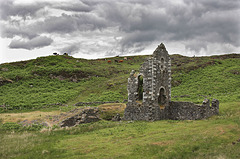tarboat's photos with the keyword: galloway
Kirkcudbright bridge
| 21 Jul 2022 |
|
|
The current bridge over the River Dee at Kirkcudbright was built in 1926 by the engineers Mouchel, replacing an earlier bridge built in 1868.
Tongland Hydro
| 08 Feb 2012 |
|
Tongland, on the Dee just north of Kirkcudbright, is the largest power station in the Galloway Hydro Electric Power Scheme, producing 33 megawatts. (MW) . It was built in 1935 in the Art Deco style. The turbine hall, houses three 11 MW horizontal-running turbines. Drawing water from Tongland Loch and Loch Ken, power is generated at 11,500V and then stepped up to the 132,000V of the national grid by transformers in a compound behind the photographer.
The power station is now operated by Scottish Power remotely from a control centre at Glenlee Power Station.
A series of old photographs of the site and its construction can be found here .
Mutehill corrugations
| 28 Dec 2010 |
|
A collection of corrugated iron structures at Mutehill just outside Kirkcudbright.
Airds Copper Mine shaft
| 04 Jan 2011 |
|
In 1843 a copper mine was opened up on the coast, south of Dalbeattie at Airds Farm, but lasted only a few years before the pumps failed and it was inundated.
In 1951 local barytes miners W.T.Shaw and J.W.Simpson, took out a 21-year lease of the area and opened up the old copper working with a view to working barytes.On finding veins of quartz,they re-collared the 75ft shaft and set up headgear'and a small crushing plant powered by a Lister diesel engine.The intention was to supply crushed quartz for pebbledashing but demand proved very small and working was intermittent.
J. W. Simpson then found good copper ore at a nearby trial and they then scrapped the quartz plant and installed a small flotation plant to treat the copper ore. The surface building was enlarged and electric plant and winder were brought from the nearby Barlocco Mine. Their diesel pumps proved insufficient and mains electric pumping was introduced which enabled them to drain the Airds shaft down to the 30 fathom level .
After following the main vein to that discovered by Simpson's little more copper found and, despite working as deep as they could manage the prospects proved poor. With copper prices low it was uneconomic to work the ore they had found and so the pumps were stopped on 5th September 1957. All the gear from the mine was salvaged before the water reached the adit. After a period of use for barytes dressing the mill closed by April 1961 and the shaft was capped.
This view shows the original rectangular shaft with the later concrete work resting upon the rock head. The water can be seen further down, presumably at sea level.
Southerness
| 10 Jul 2010 |
|
Niamh takes time out to explore the beach at Southerness on our recent Scottish trip.
Southerness Point lies on the Solway Firth to the south of Dumfries. The lighthouse was originally erected in 1749 as a marker to aid ships entering the Nith Estuary and was raised in 1795. A light was added in about 1800 and the tower was raised again in 1843-44. It is now disused, the light having been taken out of use in the mid-1930s.
Pibble
| 27 Jun 2010 |
|
|
High up in the hills above Creetown stand the remains of the Pibble mine which produced lead and a small amount of copper in the 1840s and early 1850s. The enginehouse is supposed to have accommodated a pumping engine supplied to the Creetown Copper & Lead Mining Co in 1852 by Hodges' St Austell Foundry. However, there is evidence on the site that suggests that the works were not completed and it may be that the fine building was erected more to persuade investors of the substantial nature of the undertaking rather than to meet any actual pumping rquirement.
Sadly, the bob wall has collapsed into the shaft and the remaining walls will not last too much longer.
Tongland Power Station
| 01 Jul 2010 |
|
Tongland, on the Dee just north of Kirkcudbright, is the largest power station in the Galloway Hydro Electric Power Scheme, producing 33 megawatts. (MW) . It was built in 1935 in the Art Deco style. The turbine hall, houses three 11 MW horizontal-running turbines. Drawing water from Tongland Loch and Loch Ken, power is generated at 11,500V and then stepped up to the 132,000V of the national grid by transformers in a compound behind the photographer.
The power station is now operated by Scottish Power remotely from a control centre at Glenlee Power Station.
Jump to top
RSS feed- tarboat's latest photos with "galloway" - Photos
- ipernity © 2007-2024
- Help & Contact
|
Club news
|
About ipernity
|
History |
ipernity Club & Prices |
Guide of good conduct
Donate | Group guidelines | Privacy policy | Terms of use | Statutes | In memoria -
Facebook
Twitter







